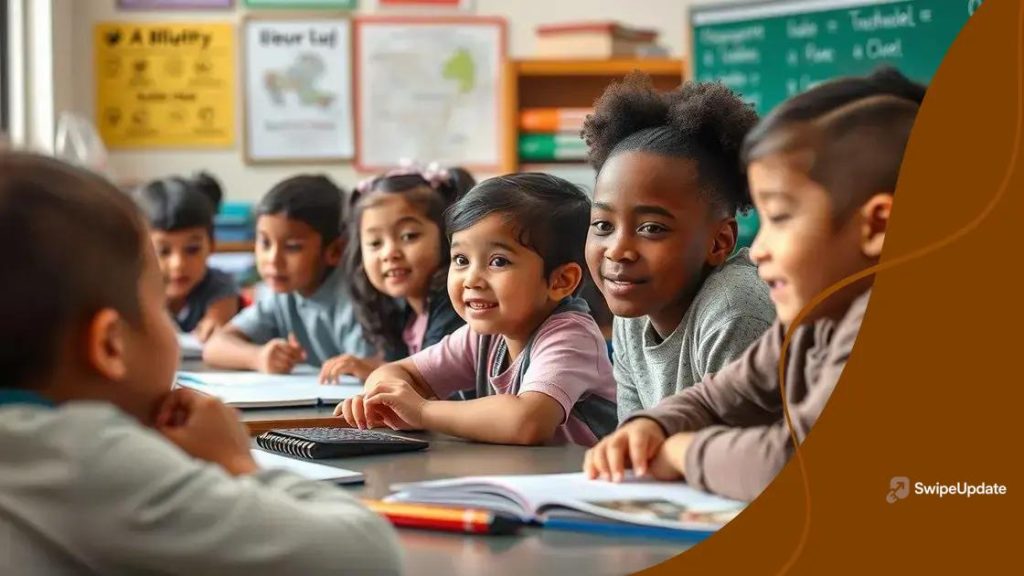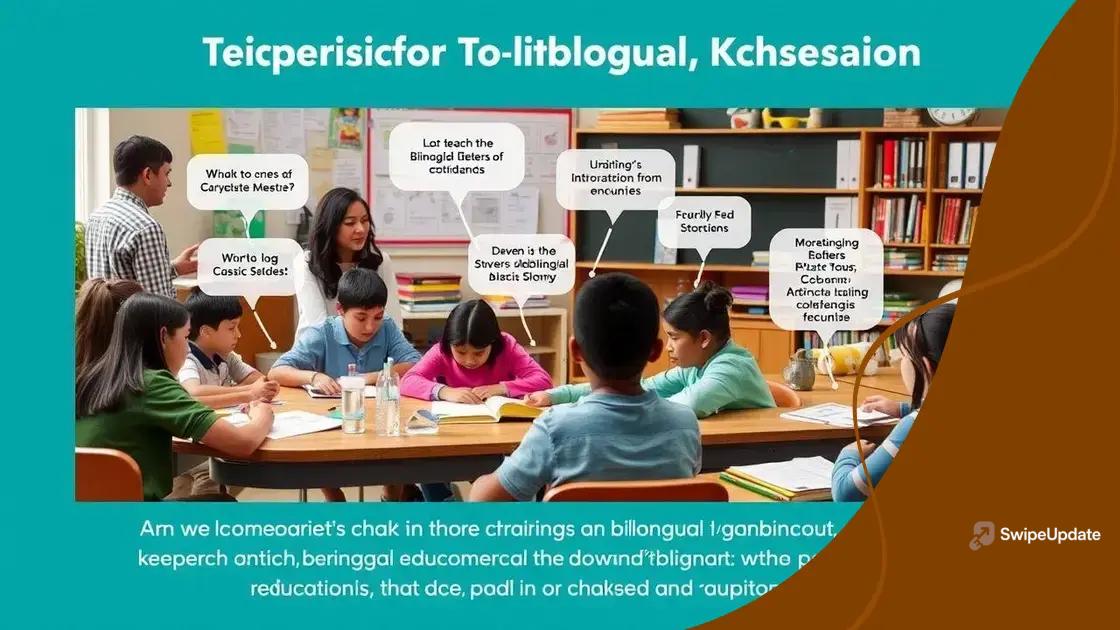Bilingual classrooms: unlocking potential for every student

Bilingual classrooms enhance language skills and cultural awareness, preparing students for global opportunities while integrating technology and personalized learning approaches.
Bilingual classrooms offer a transformative approach to education, blending language learning with cultural exchange. Have you considered how they enrich our students’ lives and broaden their horizons? Let’s dive into the fascinating world of bilingual education.
Understanding bilingual classrooms
Bilingual classrooms are spaces that enhance the learning experience for students by integrating two languages in the curriculum. These classrooms not only foster language development but also promote cultural understanding among students. Let’s explore how they function and the benefits they provide.
What Makes Bilingual Classrooms Unique?
In a bilingual classroom, educators use both languages to teach various subjects, including math, science, and social studies. This method allows students to grasp complex concepts while being immersed in a language different from their native tongue. Some key characteristics include:
- Classroom activities in both languages.
- Cultural heritage integration through discussions and projects.
- Opportunities for collaboration among students from diverse backgrounds.
The innovative teaching strategies employed in these settings help improve students’ cognitive abilities. Research shows that bilingual education can lead to enhanced problem-solving skills and creativity. By regularly switching between languages, students develop stronger cognitive flexibility.
Benefits of Bilingual Classrooms
Besides language proficiency, bilingual classrooms offer numerous benefits. They are known to:
- Encourage appreciation for different cultures.
- Boost self-esteem as students become proficient in multiple languages.
- Prepare students for a globalized world where multilingualism is an asset.
Students in these environments often demonstrate higher academic achievement. This is partly due to their enhanced communication skills and adaptability to various situations. Moreover, educators find that teaching in a bilingual context can lead to more engaged learning experiences.
As we delve deeper into the structure and methodology of bilingual classrooms, it’s clear that they are not just about teaching a second language; they are about building bridges that connect cultures and ideas. The collaborative spirit found in these classrooms allows students to thrive in an increasingly interconnected world.
Benefits of bilingual education
Bilingual education offers numerous advantages that extend beyond merely learning another language. It provides students with unique skills that can greatly enhance their overall educational experience. By being part of a bilingual program, students gain valuable insights into different cultures while developing language proficiency.
Enhanced Cognitive Skills
Research shows that students in bilingual education experience better cognitive development. They often demonstrate:
- Improved problem-solving abilities.
- Stronger critical thinking skills.
- Greater creativity in their approaches to learning.
These cognitive benefits are critical as they prepare students for challenges in various fields. By learning two languages, students are training their brains to think in more flexible ways.
Academic Achievement
Students in bilingual classrooms frequently outperform their peers in standardized tests. This advantage is largely due to their immersive learning environment. Subjects are taught in both languages, allowing students to comprehend and analyze information from different perspectives. Additionally, the ability to communicate in more than one language further equips students for academic success.
Bilingual education also enhances students’ engagement and participation. Through collaborative activities, learners become more involved in their education, which can lead to higher retention rates. Connecting with a diverse set of peers fosters a sense of community, which can make learning more enjoyable.
Future Career Opportunities
In today’s globalized world, bilingualism is an invaluable asset in the job market. Employers often favor candidates who possess language skills. Bilingual education helps students stand out, offering them a competitive edge. Many fields, including international business, healthcare, and education, actively seek bilingual professionals.
Furthermore, being fluent in multiple languages can open doors to various career paths. Students can explore opportunities both locally and internationally, expanding their horizons significantly. Emphasizing the importance of bilingual education today lays the groundwork for successful futures tomorrow.
Challenges in implementing bilingual programs

Implementing bilingual programs can be a rewarding but challenging process. Schools often face several hurdles when trying to establish these programs effectively. Understanding these challenges is essential for creating a successful bilingual education environment.
Resource Limitations
One of the most significant challenges is the lack of resources. Many schools struggle to find:
- Qualified bilingual teachers who can effectively deliver content in two languages.
- Access to appropriate teaching materials in both languages.
- Funding to support bilingual education initiatives and training programs.
These resource constraints can hinder the development of a robust bilingual program. Without adequate support, it becomes difficult to provide students with the high-quality education they deserve.
Cultural Barriers
Cultural attitudes towards language learning can also pose challenges. Some families may have concerns about:
- Maintaining their native language while learning another.
- Potential stigma associated with bilingualism.
- Fear that learning two languages will confuse their children.
These cultural barriers can prevent full participation in bilingual programs. Educators must work to build trust and understanding with families to encourage support for language learning.
Curriculum Development
Designing an effective bilingual curriculum can be complex. Educators must ensure that:
- Both languages are integrated seamlessly into the curriculum.
- Content knowledge is not sacrificed for language learning.
- Students are engaged and able to learn effectively in both languages.
This balance requires careful planning and ongoing assessment to ensure that all students are meeting their educational goals.
Overcoming these challenges requires collaboration among educators, administrators, and families. By addressing resource limitations, cultural barriers, and curriculum standards, schools can create a more effective bilingual program.
Best practices for educators
Implementing effective bilingual education requires educators to adopt best practices that enhance student learning. Schools need to foster an engaging and supportive atmosphere to help students thrive in a bilingual setting. Here are some strategies that can make a difference in the classroom.
Creating an Inclusive Environment
An inclusive environment is essential for all students. Educators should:
- Encourage students to share their cultural backgrounds.
- Provide materials in both languages.
- Arrange activities that celebrate cultural diversity.
When students feel valued and included, they are more likely to participate fully in their learning. This sense of belonging fosters a positive atmosphere in bilingual classrooms.
Using Interactive Teaching Methods
Interactive teaching methods can enhance language acquisition. Incorporating hands-on activities keeps students engaged and makes learning fun. Activities such as:
- Group discussions on relevant topics.
- Role-playing different scenarios.
- Games that promote vocabulary and language skills.
These approaches allow students to practice both languages actively. When students are interacting with their peers, they also build important social skills.
Continuous Professional Development
Educators should participate in ongoing training to improve their bilingual teaching strategies. Professional development opportunities that focus on:
- New methodologies for language instruction.
- Inclusive education practices.
- Effective assessment techniques.
By staying up to date with the latest research and teaching methods, educators can ensure that they are providing the best learning experiences for their students.
Encouraging collaboration among teachers also fosters sharing of successful practices. This teamwork can lead to enhanced curriculum planning and improved student outcomes in bilingual education.
Future trends in bilingual education
The future of bilingual education holds exciting possibilities as schools adapt to a rapidly changing world. With increasing globalization, the demand for bilingualism is rising. This trend is influencing how educational systems approach language learning.
Integration of Technology
One of the most noticeable trends is the integration of technology in bilingual classrooms. Educators are using:
- Online platforms for language practice.
- Apps designed to improve vocabulary and grammar.
- Interactive software that engages students in both languages.
These tools provide students more opportunities to practice their language skills beyond the classroom. Moreover, technology can cater to different learning styles, making it easier for all students to grasp complex concepts.
Emphasis on Cultural Competence
As bilingual programs evolve, there is a growing emphasis on cultural competence. Educators recognize the importance of teaching students not just language, but also about:
- The cultures associated with the languages.
- Global citizenship and acceptance of diversity.
- Effective communication in multicultural environments.
This focus prepares students to navigate a globalized society. Understanding cultural differences is crucial in fostering respectful interactions among individuals from various backgrounds.
Personalized Learning Approaches
Personalized learning is another emerging trend in bilingual education. Teachers are increasingly tailoring their instruction to meet the needs of individual students. Strategies include:
- Adaptive learning systems that assess students’ progress.
- Flexible grouping based on language proficiency.
- Customized lesson plans that align with students’ interests.
This individualized approach allows each student to thrive in a bilingual setting. As education continues to evolve, student-centered learning will play a significant role in achieving success.
Together, these trends reflect an exciting future for bilingual education. By embracing technology, emphasizing cultural understanding, and implementing personalized learning strategies, schools can better prepare students for the diverse world ahead.
FAQ – Frequently Asked Questions about Bilingual Education
What are the main benefits of bilingual education?
Bilingual education enhances cognitive skills, promotes cultural awareness, and prepares students for global opportunities in a diverse world.
How can technology be integrated into bilingual classrooms?
Technology can be used through online platforms, apps, and interactive software that support language learning and engage students effectively.
What challenges do educators face when implementing bilingual programs?
Some challenges include resource limitations, cultural barriers, and the need for a well-developed bilingual curriculum to meet student needs.
What trends are shaping the future of bilingual education?
Future trends include increased technology use, a focus on cultural competence, and personalized learning approaches tailored to individual students’ needs.
